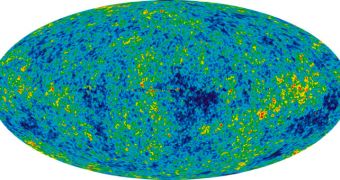Investigators have recently taken a closer look at a background layer of subatomic particles, that was found some time ago to permeate the entire Universe. Similar to the cosmic microwave background (CMB), this collection of particles was also produced in the earliest moments of the Cosmos.
This subatomic signature spreads throughout the firmament, similar to how microwaves do. However, unlike these photons, the second background is made up of relic neutrinos, elementary particles that feature no mass and no electrical charge.
They can pass unimpeded through matter, and its estimated that billions of them pass through the Earth every single second. Neutrinos are also notoriously difficult to detect. Specialized instruments built with billions of dollars in funds only detect a handful of them per year.
The Big Bang – the event that expanded our Universe into being some 13.75 billion years ago – is widely believed to be responsible for the production of the cosmic neutrino background (CNB).
According to physicists, there are multiple sources for neutrinos, including nuclear reactions, both on Earth and on the Sun, and other stars and galaxies. Astrophysicists explain that the Big Bang was probably the most important source of neutrinos ever.
The event cause a massive background of these particles. As the Universe began expanding over the eons, this layer expanded as well, until it finally permeated every corner of space, Daily Galaxy reports.
“We're talking maybe up to roughly ten billion light-years” for each individual neutrino, explains University of California in San Diego (UCSD) expert George Fuller, the coauthor of a new study on this issue.
“That's nearly on the order of the size of the observable Universe,” the investigator adds, speaking about the ranges in which these elementary particles can exist. Fuller conducted this research with student Chad Kishimoto.
The team published details of its investigation in a paper appearing in the May 22 issue of the esteemed scientific journal Physical Review Letters. The work proposes that the reasons why neutrinos remained intact over so much time is precisely because they are able to pass through normal matter.
“Quantum mechanics was intended to describe the universe on the smallest of scales, and now here we're talking about how it works on the largest scales in the Universe. We're talking about physics that hasn't been explored before,” Kishimoto says.
“These neutrinos could be a path to something deeper in our understanding with gravity,” comments University of California in Berkeley (UCB) physicist Adrian Lee, who was not a part of the new research.

 14 DAY TRIAL //
14 DAY TRIAL //